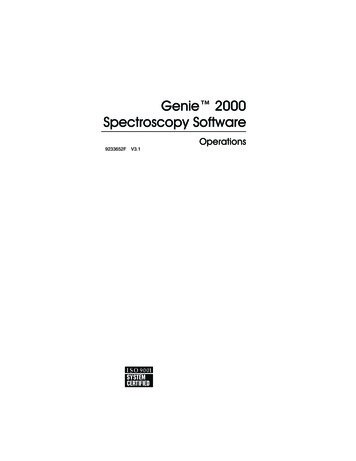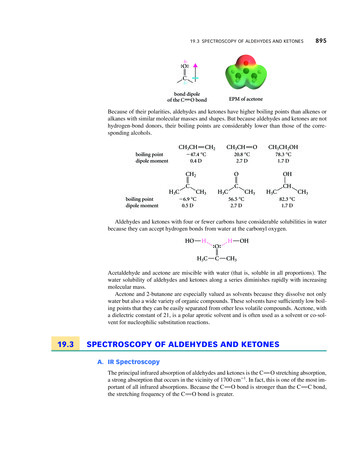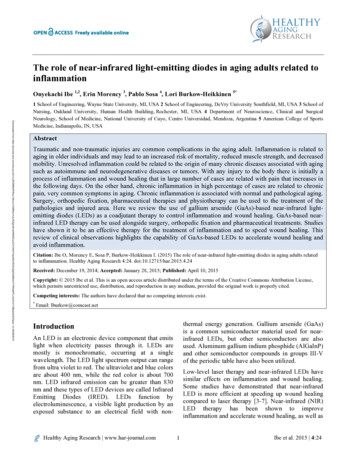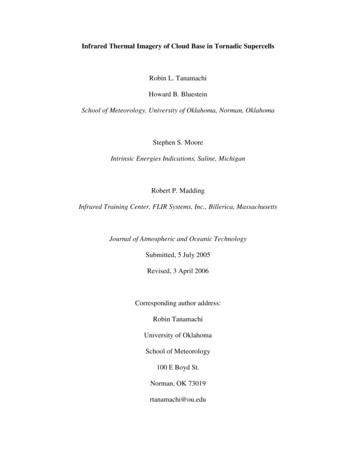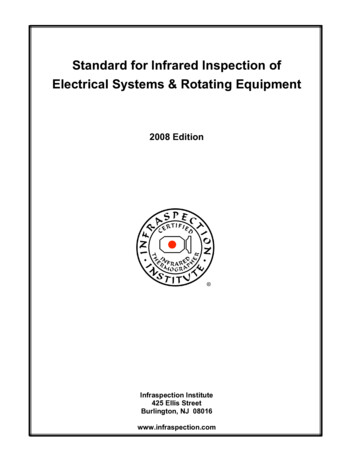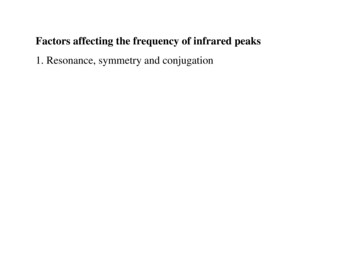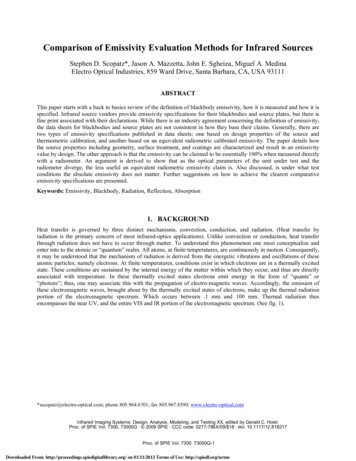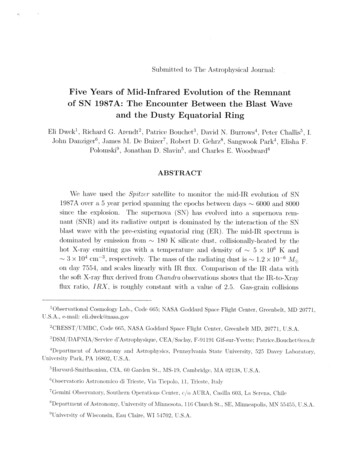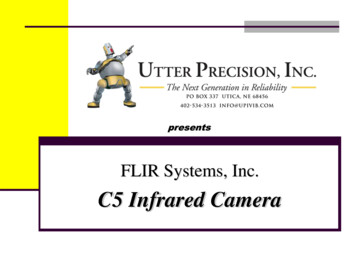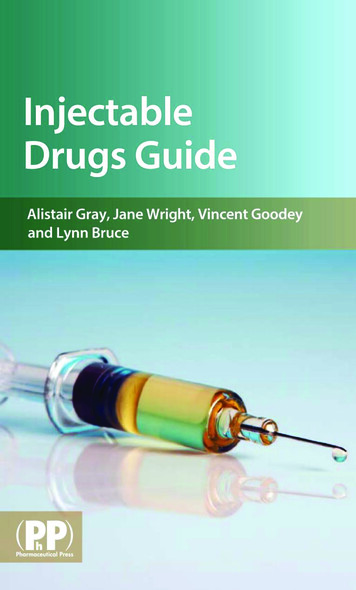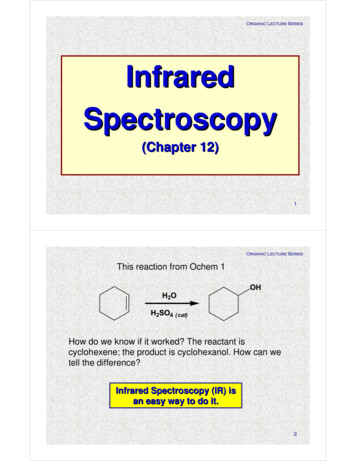
Transcription
Organic Lecture SeriesInfraredSpectroscopy(Chapter 12)1Organic Lecture SeriesThis reaction from Ochem 1How do we know if it worked? The reactant iscyclohexene; the product is cyclohexanol. How can wetell the difference?Infrared Spectroscopy (IR) isan easy way to do it.2
Organic Lecture Series3Organic Lecture SeriesElectromagnetic Radiation Electromagnetic radiation: light and otherforms of radiant energy Wavelength (λ): the distance betweenconsecutive peaks on a wave Frequency (ν): the number of full cycles ofa wave that pass a given point in a second Hertz (Hz): the unit in which radiationfrequency is reported; s-1 (read “persecond”)4
Organic Lecture SeriesElectromagnetic Radiation Common units used to expresswavelengthλUn itMeter (m)Millimeter (mm)Micrometer (μm)N anometer (nm)An gs trom (Å )Relationto Meter---1 mm 10-3 m1 μm 10-6 m1 nm 10-9 m1 Å 10-10 mc λνE hνE is kJ/molh 3.99 X 10-13 kJzszmol-1ν frequency in Hz5Organic Lecture SeriesE hν6
Organic Lecture SeriesInfrared Spectroscopy The vibrational IR extends from 2.5 x 10-6 m (2.5μm) to 2.5 x 10-5 m (25 μm)– the frequency of IR radiation is commonly expressed inwavenumbers– Wavenumber ν: the number of waves per centimeter, withunits cm-1 (read reciprocal centimeters)– expressed in wavenumbers, the vibrational IR extendsfrom 4000 cm-1 to 400 cm -1-2-1-1ν 10 m cm 4000 cm2.5 x 10-6 mν 10-2 m cm -12.5 x 10-5 m25 μm to 2.5 μm-1 400 cm7Organic Lecture SeriesSections of an IR SpectrumThis is the most common scale.8
Organic Lecture Series IR spectrum of 3-methyl-2-butanoneStrongabsorption9Organic Lecture Series IR spectrum of 3-methyl-2-butanoneC-HStretchC OStretch10
Organic Lecture SeriesMolecular Vibrations–atoms joined by covalent bonds undergo continualvibrations relative to each other–the energies associated with these vibrations arequantized; within a molecule, only specificvibrational energy levels are allowed–the energies associated with transitions betweenvibrational energy levels correspond tofrequencies in the infrared region:4000 to 400 cm-111Organic Lecture Series For a molecule to absorb IR radiation– the bond undergoing vibration must be polar and– its vibration must cause a periodic change in thebond dipole moment Covalent bonds which do not meet thesecriteria are said to be IR inactive– the C-C double and triple bonds of symmetricallysubstituted alkenes and alkynes, for example, areIR inactive because they are not polarized bondsH3 CCH3C CH3 CCH3H3 C- C C- CH32,3-Dimethyl-2-butene2-Butyne12
Organic Lecture SeriesMolecular Vibrations Consider two covalently bonded atoms as twovibrating masses connected by a spring– the total energy is proportional to the frequency of vibration– the frequency of a stretching vibration is given by anequation derived from Hooke’s law for a vibrating springν 4.12KμK a force constant, which is a measure of the bonds’strength; force constants for single, double, and triplebonds are approximately 5, 10, and 15 x 105 dynes/cmμ reduced mass of the two atoms, (m1m2)/(m1 m2),where m is the mass of the atoms in grams13Organic Lecture SeriesThe simplest vibrational motions are bendingand stretching.Here are the fundamental stretching andbending vibrations for a methylene group:http://en.wikipedia.org/wiki/Infrared spectroscopy14
Organic Lecture Twisting15Organic Lecture SeriesMolecular Vibrationsν 4.12Kμ From this equation, we see that the position(i.e. wavenumber) of a stretching vibration:– is proportional to the strength of the vibrating bond– is inversely proportional the masses of the atomsconnected by the bond The intensity (i.e. weak, s, m) of absorptiondepends primarily on the polarity of thevibrating bond16
Correlation TablesOrganic Lecture SeriesTable 12.4 Characteristic IR absorptions for thetypes of bonds and functional groupsencountered most often:Bon dO-HN-HC-HC CC OC-OStretchingFrequ ency (cm 00-1250Intens ityw eak to s trongmediu mw eak to mediumw eak to mediumstrongstrong17Hydrocarbons-Table 12.5HydrocarbonAlk aneC-HCH3C-CAlk eneC-HC CAlk yn eC-HC CAreneC-HC CC-HVib rationStretchin gBend ingBend ing(N ot usefulFrequen cy-1(cm )Organic Lecture SeriesIntens ity2850 - 3000Mediu m1450-1475Mediu m1375 and 1450 Weak to mediumfor interpretation - too man y b andsStretchin gStretchin g3000 - 31001600 - 1680Weak to mediumWeak to mediumStretchin gStretchin g33002100-2250Mediu m to stron gWeakStretchin gStretchin gBend ing30301450-1600690-900Weak to mediumMediu mStrong18
Organic Lecture SeriesAlkanes IR spectrum of decane (Fig 12.4)300019Organic Lecture SeriesAlkenes IR spectrum of cyclohexene (Fig 12.5)300020
Organic Lecture SeriesAlkynes IR spectrum of 1-octyne (Fig 12.6)300021Organic Lecture SeriesAromatics IR spectrum of toluene (Fig 12.7)300022
Organic Lecture SeriesAlcoholsBondFrequency, cm-1Inten sityO-H (free)3600-3650WeakO-H (H b ond ed)C-O3200 - 35001000 - 1250Medium, broadMedium23Organic Lecture SeriesEffect of Concentration Upon Hydrogen Bonding24
Organic Lecture SeriesEffect of Concentration Upon Hydrogen Bonding25Organic Lecture SeriesEthers IR spectrum of dibutyl ether (Fig 12.9)300026
Organic Lecture SeriesEthers IR spectrum of anisole (Fig 12.10)300027Organic Lecture SeriesAmines IR spectrum of 1-butanamine (Fig 12.11)28
Organic Lecture SeriesIR of Molecules with C O GroupsCarbonyl GroupVibrationFrequency(cm-1 )IntensityORCR'KetonesC OStretching1630-1820StrongORCHAldehydesC boxylic acidsC OStretchingO HStretching1700-17252500-3300StrongStrong (broad)ORCOH29Organic Lecture SeriesIR of Molecules with C O GroupsORCNH2AmidesC OStretchin g1630-1680N HStretchin g3200, 3400(1 amides h ave tw o N -H stretches )(2 amides h ave one N -H stretch )ORCOR'Carboxylic estersC OStretchin g2Stretchin gsp C O3sp C OStretchin gO ORCOCRAcid anhydridesC OStretchin gRC NStrongMediu ngStrongMediu mC OStretchin g1740-1760 and1800-1850900-1300NitrilesC NStretchin g2200-225030
Organic Lecture SeriesAldehydes and Ketones IR spectrum of menthone (Fig 12.12)31Organic Lecture SeriesCarboxylic acids IR spectrum of pentanoic acid (Fig 12.13)32
AmideOrganic Lecture Series IR of N-methylpropanamide (Fig 12.14)33Organic Lecture SeriesEsters IR of Ethyl butanoate (Fig 12.15)34
Organic Lecture SeriesStrategies for IR InterpretationInspect the spectrum from left to right.9If there is a strong, but broad band 3500 cm-1then, OH is present. One or two weak peaks in thisarea are indicative of amines (N—H stretch).9Examine the 3000 cm-1 C—H aliphatic stretchesare to the right and C—H from alkenes & aromaticsare to the left.9Aldehyde C—H stretch will be 2720 cm-19Check the area from 1820 to 1630 cm-1. Strongpeaks in this area indicate C O and this is often thestrongest peak in the spectrum.9The area from 1250 to 1000 cm-1 are the C—Ostretches of ethers, esters, acids.35
Organic Lecture Series. 7. Infrared Spectroscopy. The vibrational IR extends from 2.5 x 10-6m (2.5 μm) to 2.5 x 10-5m (25 μm) – the frequency of IR radiation is commonly expressed in wavenumbers – Wavenumber ν: the number of waves per centimeter, with units cm-1 (read reciprocal centimeters) – expressed in wavenumbers, the vibrational IR extends .File Size: 2MBPage Count: 18People also search formass of ethyl butanoateir spectroscopy pptir spectroscopy graphir spectroscopy practiceir spectroscopy pdfir spectroscopy problems and answers

